
About UsThe Numismatic Bibliomania Society is a non-profit organization devoted to the study and enjoyment of numismatic literature. For more information please see our web site at coinbooks.org SubscriptionsThose wishing to become new E-Sylum subscribers (or wishing to Unsubscribe) can go to the following web page link MembershipThere is a membership application available on the web site Membership Application To join, print the application and return it with your check to the address printed on the application. Membership is only $20 to addresses in the U.S., $25 for First Class mail, and $30 elsewhere. For those without web access, write to: David M. Sundman, Treasurer
AsylumFor Asylum mailing address changes and other membership questions, contact David at this email address: dsundman@LittletonCoin.com SubmissionsTo submit items for publication in The E-Sylum, just Reply to this message, or write to the Editor at this address: whomren@gmail.com BUY THE BOOK BEFORE THE COINSale Calendar |
- WAYNE'S WORDS: THE E-SYLUM MAY 24, 2015
- HAPPY 104TH BIRTHDAY, ERIC NEWMAN!
- BALDWIN'S NUMISMATIC LITERATURE OFFERINGS: MAY, 2015
- NUMISMATIC LITERATURE IN MÜNZEN & MEDAILLEN JUNE 2, 2015 SALE
- NEW BOOKS: LEATHER-BOUND LIMITED EDITION RED BOOKS
- NEW BOOK: MUGHAL MINT TOWNS AND OTHER ESSAYS
- THE STRUCK COPIES OF THOMAS WYATT AND OTHERS
- WHAT'S A "COWBUCK"?
- NOTES FROM E-SYLUM READERS: MAY 24, 2015
- CONGRESSIONAL GOLD MEDAL AWARDED TO FIGHTER ACES
- CHARLES LINDBERGH’S CONGRESSIONAL GOLD MEDAL
- THE D. BRENT POGUE COLLECTION: AN APPRECIATION
- A POGUE, PART I POSTMORTEM
- HARVEY STACK AND D. BRENT POGUE
- THE BOSTON CORN EXCHANGE HOTEL TOKEN
- QUERY: WHAT’S AN OBVERSE?
- QUERY: WRITER OF GROGAN COLLECTION LETTERS SOUGHT
- MEDAL EXHIBIT: RETRATS DE MEDALLA
- BANKNOTE ENGRAVER LORENZO HATCH
- INTERVIEW: KATHERINE VAN SCHAIK
- THE MUSES ON ANCIENT COINS
- ANA 2015 SUMMER SEMINAR SCHEDULE ANNOUNCED
- HEINRICH WIELAND'S NOBEL MEDAL SELLS FOR $395,000
- SOTHEBY'S PLANNING MONEY-THEMED ART SALE
- A 1949 CADILLAC COVERED WITH CENTS
Click here to access the complete archive
To comment or submit articles, reply to whomren@gmail.com
WAYNE'S WORDS: THE E-SYLUM MAY 24, 2015

New subscribers this week include: Roger Lalich, courtesy of John and Nancy Wilson. Welcome aboard! We now have 1,856 subscribers.
This week we open with birthday wishes to America's leading numismatic scholar, Eric Newman, literature offerings from Baldwin's and Münzen & Medaillen, three new books, and Colonial copies inspired by numismatic literature.
Other topics include Congressional Gold Medals old and new, the D. Brent Pogue collection. Banknote engraver Lorenzo Hatch, the ANA Summer Seminar, and money-themed art.
To learn more about Pinkerton'sEssay on Medals, the complete works of Helen Farquhar, the famous (or infamous) Wyatt copies, cowbucks, the Boston Corn Exchange token, the silver drachm from the island of Cos, and the 1949 Cadillac covered with cents, read on. Have a great week, everyone!
Wayne Homren
Editor, The E-Sylum
HAPPY 104TH BIRTHDAY, ERIC NEWMAN!
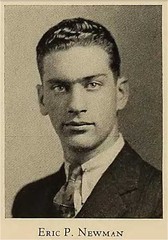
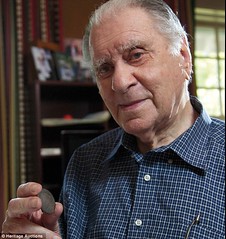
On the Yahoo Colonial Coins group, Phil Mossman writes:
For those C4ers who may not know him, Eric is the most extraordinary person I’ve ever met in our field – so obliging and capable of sharing his unparalleled knowledge, expertise, and personal resources for the advancement of numismatics. I first met him in 1986 when, after the publication of my CNL 74, he phoned me to introduce himself and offer his assistance in my fledgling research career. And he certainly did that and has continued to do so over all these years! I’m sure there are many other people and organizations who can repeat the same story! Happy Birthday Eric!
Joel Orosz writes:
If the ANS still had a pediment, Eric Newman's name would be the second American scholar to have his name carved into it--and he's still researching and writing! Happy 104th to a numismatist nonpareil!
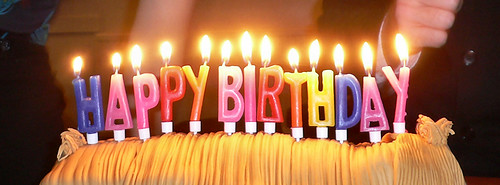
Eric's son Andy Newman writes:
It's on Memorial Day this year so he's enthusiastic about our going to a big Memorial Day buffet at a club here. Mucho cake and ice cream.
To read the earlier E-Sylum article, see:
HAPPY BIRTHDAY, ERIC NEWMAN! (www.coinbooks.org/esylum_v17n22a02.html)
BALDWIN'S NUMISMATIC LITERATURE OFFERINGS: MAY, 2015
Pinkerton, J. An Essay on Medals
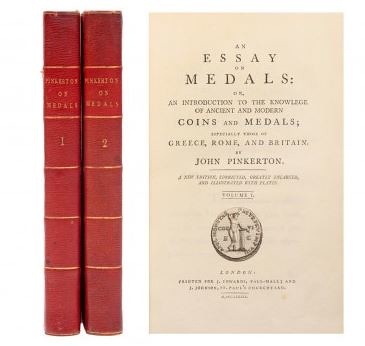
Pinkerton, J. An Essay on Medals: Or, An Introduction to the Knowledge of Ancient and Modern Coins and Medals; Especially Those of Greece, Rome, and Britain. London, 1789. Two volumes. Octavo, pp. xlviii, 302; iv, 364; 6 finely engraved plates. Beautifully bound in contemporary full crimson morocco, ruled and lettered in gilt, all edges and inner dentelles gilt. Marbled endpapers, original silk markers. Two finely engraved armorial ex-libris in the first volume, one unnamed, the other that of notorious coin thief William Durrant (d.1846), along with the distinctive bookplate of Phiroze Randeira in both volumes. Two contemporary sheets of manuscript notes, possibly in the hand of William Durrant, are loosely inserted, the first states that this volume was bought ‘at a sale at Evans July 5 1820…fine copy morocco’, this however cannot be accurate as Evans did not begin as an auctioneer until 1822.
A subsequent note in a later hand accompanies a clipping pasted onto the same sheet and states that the book was later purchased through well-known bookseller Bernard Halliday in Leicester in 1951 and that this book, along with many others, came from Scottow Hall in Norwich which was the Durrant family seat and which contained, perhaps naturally, many numismatic items. The second sheet, (dated 1802) has been inserted into the second volume and gives the prices realised and locations for coins illustrated in these plates, examples of which were sold in the contemporaneous Tyssen sale which Durrant would have attended. A beautiful set of books with a most interesting provenance. Rare thus.
For more information, or to order, see:
A Beautiful Copy of Pinkerton's Work on
Coins & Medals (www.baldwin.co.uk/a-beautiful-copy-of-pinkerton-s-work-on-coins-medals.html)
Catalogue Des Monnaies Gauloises de la Bibliothèque Nationale
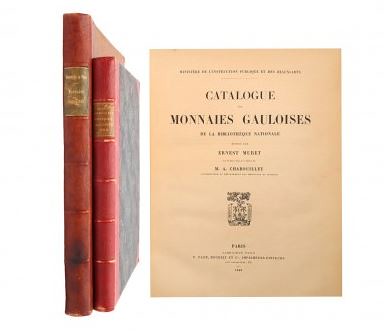
Muret, E. & Chabouillet, M. A. Catalogue Des Monnaies Gauloises de la Bibliothèque Nationale. Paris, 1889. Large quarto, pp. xxvii, (1), 327, (1). Half red morocco with marbled boards, raised bands, yellow label in second compartment lettered in gilt. With; De La Tour, H. Atlas de Monnaies Gauloises Préparé Par Le Comission De Topographie Des Gaules et Publié Sous led Auspices du Ministère de L’Instruction Publique. Paris, 1892. Large quarto, pp. iv, (2), 12; 55 beautifully engraved plates by Dardel. Mean half morocco over later cloth boards, raised bands, green morocco title label to spine, lettered in gilt. Both books scuffed at extremities, contents very good with only minimal browning A good set of this major catalogue of the French National collection of Gaulish coins, complete with the very scarce volume of plates. Clain-Stefanelli 5144 & 5139*.
For more information, or to order, see:
Muret & Chabouillet on Gaulish
Coins with Superb Plates by Dardel (www.baldwin.co.uk/muret-chabouillet-on-gaulish-coins-with-superb-plates-by-dardel.html)
A Magnificent Set of Farquhars Complete Works
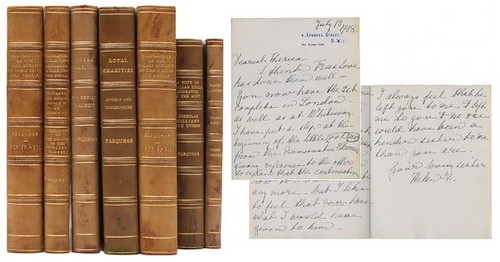
Farquhar, H. Seven finely bound volumes containing all thirty four papers written by Helen Farquhar, ‘the doyenne of British numismatics’, for both the Numismatic Chronicle and the British Numismatic Journal. Compiled by Helen and bound for her sister Theresa in circa 1938. London, 1906 -1936. Quarto and octavo. A wonderful archive containing a wealth of information and including Farquhar’s most important works including all of the ‘Royal Charities’ papers as well as all seven parts of the ‘Portraiture of Our Stuart Monarchs’ series.
Also inserted are two obituaries, the first written by Christopher Blunt in the Numismatic Circular and the second from the Times, both accurately confirming the importance of Helen’s work and her esteemed place within the numismatic world, ‘She was the last survivor of the generation of British numismatists which flourished before and after the First World War. Her many younger friends will remember her with affection as a very great lady”. Possibly the finest and most complete set of Helen Farquhar’s work to have been offered and especially attractive with such a personal provenance. Exceptionally rare thus.
For more information, or to order, see:
A Magnificent Set of Farquhars Complete Works
(www.baldwin.co.uk/a-magnificent-set-of-farquhars-complete-works.html)
Humphreys Coinage of the British Empire
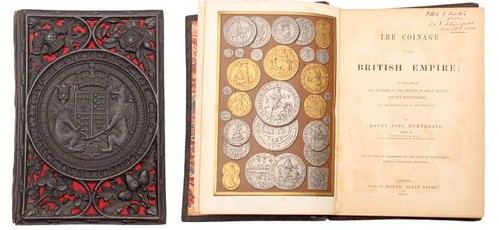
Humphreys, H. N. The Coinage of the British Empire: An Outline of the Progress of the Coinage in Great Britain and her Dependencies. London, 1855. Quarto, pp. colour plate as frontispiece, 160, 23 plates in total, 12 line drawn, the remaining 11 are stunning chromolithographic plates produced in gold, silver and copper. Some offsetting but contents otherwise clean. Beautifully and extravagantly bound in the original papier mache boards, designed to imitate carved oak and done in the style of the reverse of a Henry VIII Sovereign complete with the original legend around the edge and surrounded in each corner by emblematic symbols representing England (a Tudor rose and acorn), Scotland (a thistle) and Ireland (the shamrock). Original cloth spine, marbled endpapers, all edges gilt. Hinges weak as is to be expected, boards a little worn, the back with some small cracks and the edges chipped but on the whole an exceptional example of this highly ornate Victorian binding which rarely survives intact. A wonderful copy. Rare thus.
For more information, or to order, see:
In a Beautiful Victorian Papier Mache Binding
(www.baldwin.co.uk/in-a-beautiful-victorian-papier-mache-binding.html)
NUMISMATIC LITERATURE IN MÜNZEN & MEDAILLEN JUNE 2, 2015 SALE
Hoffmann 1715
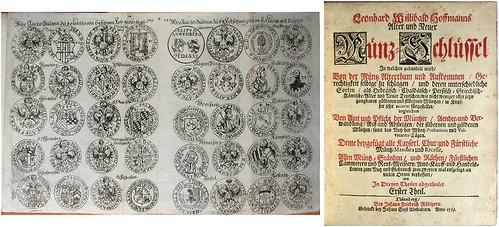
HOFFMANN, LW Old and new coin key. Improved ed. Nürnberg 1715. frontispiece, Kupferstichabb., Several tables and folding plates. Coin Prob, 62 p, 35 Tf .; Report. whether bey creation of the world already Gold and Silver = Seyen been = coins or not (chapter on the creation of money); 363 pages, with about 80 in the bound text folding plates, the majority of which have Kupferstichmünzabbildungen. A loose Engraving (pg 135). Halblederband time with marbled covers and back gold coins. Bookplate. Cover slightly rubbed and bumped, inside fresh, clean copy. II-III
For more information, or to bid, see:
Lot 1199
(www.sixbid.com/browse.html?auction=1972&category=40560&lot=1706908)
Gilhofer & Ranschburg, 1935
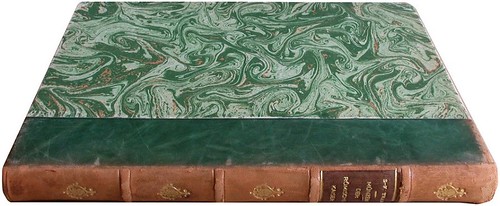
GILHOFER & RANSCHBURG, Vienna, and HESS AG, Lucerne. auction from 22. 5. 1935. Coll. F. maid. Coins of the Roman emperors. 2 Portrait panels, 130 S. with 4727 Nos., 53 pl., SL. Hldr. with marbled covers and back gold coins. Bookplate. II
For more information, or to bid, see:
Lot 1406
(www.sixbid.com/browse.html?auction=1972&category=40560&lot=1707115)
THE BOOK BAZARRE
NEW BOOKS: LEATHER-BOUND LIMITED EDITION RED BOOKS
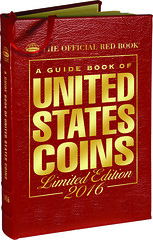 Whitman Publishing announces the release of the 2015 and 2016 Limited Editions of A Guide Book of United States Coins (the hobby’s
popular retail-pricing guide known as the “Red Book”). The 448-page leather-bound books will be available June 23, 2015, including online
at www.Whitman.com, for $99.95 each. Each is limited to a print run of 500 copies.
Whitman Publishing announces the release of the 2015 and 2016 Limited Editions of A Guide Book of United States Coins (the hobby’s
popular retail-pricing guide known as the “Red Book”). The 448-page leather-bound books will be available June 23, 2015, including online
at www.Whitman.com, for $99.95 each. Each is limited to a print run of 500 copies.
These special volumes are published in a large format (6.25 by 9.25 inches, compared to 5.25 by 7.75 inches for the regular edition). Each copy is individually numbered and personally autographed by Red Book senior editor Kenneth Bressett. The Limited Editions are handsomely constructed with red-leather binding, gold-stamped lettering on the covers, gilt-edged pages, a hubbed spine, high-quality paper, and a silk page marker. A Certificate of Limited Edition is bound into each copy.
“Over the years, the Limited Edition Red Book has become a collectible in its own right,” says Whitman publisher Dennis Tucker. “Past editions have sold out with 1,000 to 3,000 copies printed. This scarcity is multiplied by a low print run of just 500 copies each for the 2015 and 2016 editions.”
The first leather-bound Limited Edition Red Book was the 2005-dated version, introduced in 2004. Numismatic historian Frank J. Colletti catalogs and discusses the early Limited Editions in chapter 5 of the Guide Book of the Official Red Book of United States Coins.
“As you might suspect, I am an avid collector of every issue and variety of the Red Book,” said senior editor Kenneth Bressett. “The Limited Editions are the pride of my set and a highlight of my entire library.”
Rare books, auction catalogs, periodicals, and other literature comprise a specialized field of collecting in numismatics. Enthusiasts are encouraged to join the Numismatic Bibliomania Society (online at www.coinbooks.org), an educational organization founded in 1979 to support and promote the use and collecting of numismatic literature.
# # #
A Guide Book of United States Coins, Limited Edition, 2015 (68th) edition and 2016 (69th) edition.
By R.S. Yeoman; senior editor Kenneth Bressett, research editor Q. David Bowers, valuations editor Jeff Garrett.
ISBN 0794842208 (2015 edition), 0794843220 (2016 edition).
448 pages, full color.
Retail $99.95 U.S.
For more information, or to order, see:
2015 Limited Edition Leather Red
Book (www.whitman.com/store/Inventory/Detail/2015-Limited-Edition-Leather-Red-Book+0794842208)
2016 Limited Edition Leather Red
Book (www.whitman.com/store/Inventory/Detail/2016-Limited-Edition-Leather-Red-Book+0794843220)
NEW BOOK: MUGHAL MINT TOWNS AND OTHER ESSAYS
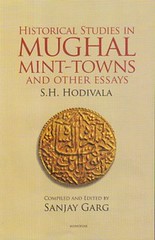 Title: Historical Studies in Mughal Mint Towns and Other Essays
Title: Historical Studies in Mughal Mint Towns and Other Essays
Authors (s): Sanjay Garg (Editor) , Sanjay Garg (Compiler)
Format: Hardcover
ISBN-13: 9789350980576
Pages: 424p.,
Pub. date: 31.12.2014, 1st. ed.
Publisher: Manohar Publishers & Distributors
Language (s): English
Bagchee ID: BB93676
List price: US $ 99,00
Bagchee price: US $ 89,10
Shahpurshah Hormasji Dinshahji Hodivala (1867-1944), was an iconic figure in the field of medieval Indian numismatics and his contribution to the study of Mughal Numismatics is unequalled. In 1923 he published his seminal work on the coins of the Mughal rulers of India Historical Studies in Mughal Numismatics. It has served as a beacon of light to the students of Mughal Numismatics for over ninety years.
The present volume contains 34 papers of Hodivala which were published over a span of 18 years (between 1915 and 1933). Most of these articles deal with the mint-towns of the Mughals. The essays have been grouped thematically for easy reference and a chronological list of the original publication has been given separately as an appendix. A comprehensive bibliography has been added to make the work a veritable research tool.
Also included in the volume are eight unpublished letters written by Hodivala to another great numismatist of his times, R.B. Whitehead. These letters which are now part of the Whitehead Papers, in the archival collection of the Fitzwilliam Museum, Cambridge, cover a period of twelve years and shed interesting light on the otherwise obscure life of this great savant of Mughal numismatics.
This volume provide a much needed fillip in rekindling serious research in Mughal numismatics based on original sources that Hodivala so zealously propounded.
For more information, or to order, see:
Historical Studies in
Mughal Mint Towns and Other Essays
(www.bagchee.com/books/BB93676/historical-studies-in-mughal-mint-towns-and-other-essays-s-h-hodivala/)
THE STRUCK COPIES OF THOMAS WYATT AND OTHERS
The first couple of coins on this list are the famous (or infamous) Wyatt copies of Massachusetts silver colonials. They have been avidly collected since they were made in the 1850's. All of these coins have been slabbed by PCGS. I gotta tell you – they are sweet eye candy when you see these coins in PCGS holders. For a brief second it seems you are looking at the genuine article (though no experts would be fooled by these, of course).
(“1652”) New England Shilling. Wyatt Copy in Silver. PCGS graded EF-40.
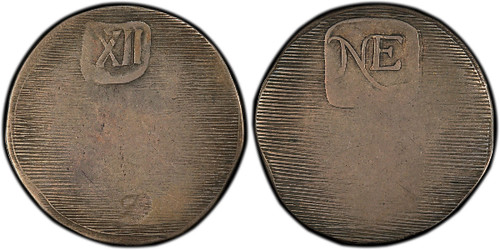
Noe-1, Kenney-1, W-14020. Attractive medium gray with light pastel iridescence in varied tones. A rare early struck copy, produced by numismatist Thomas Wyatt about 1856. The engraver based the design on illustrations published in Joseph Felt's 1839 An Historical Account of the Massachusetts Currency. He included the cross-hatching lines found in the Felt illustrations, which themselves copied engraved plates published by Martin Folkes in 1745. This is the only specimen graded by PCGS in any grade so far; it comes with a PCGS CoinFacts image. Listed on the Noe plates as a counterfeit. $1450.
"1652" (1850s) Oak Tree Twopence. Wyatt Copy in Silver. PCGS graded MS-63.
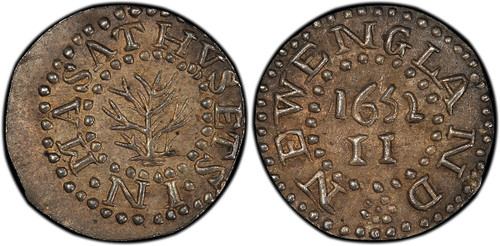
Noe-OB, Kenney-6, W-14030. Really high grade for one of these, essentially as struck and showing good frosty luster over lightly toned golden-gray surfaces. An unusual piece that was never worn in an attempt to pass it as genuine. Ford never obtained an example. This is one of only 2 specimens graded by PCGS in any grade so far and the finer of the two; it comes with a PCGS CoinFacts image. Listed on the Noe plates as a counterfeit. $875
"1652" (1850s) Good Samaritan / Oak Tree Shilling. Wyatt copy in Silver. PCGS graded MS-63.
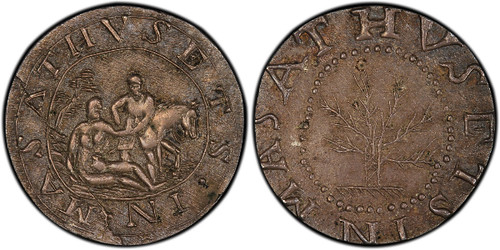
Kenney-8/3 Mule, W-14092. Struck by Edwin Bishop after his acquisition of Thomas Wyatt's dies. Lustrous even gray, with hints of blue.
This is perhaps the most famous design of all of the collectible 19th Century struck copies and fantasies. The “original” of this design was actually a fabrication made from a genuine pine tree shilling and housed in the British Museum.
Good Samaritan Shillings were listed in the Redbook as genuine for many years. To quote from the 9th Edition of that reference: “The Good Samaritan Shilling, supposed to be a pattern piece, was struck at the Boston mint and is extremely rare. This piece is of the same general type as the Pine Tree Shilling, but has a device illustrating the parable of the Good Samaritan on The obverse. “
Thus, these Wyatt copies are themselves copies of a concoction that never existed in 17th century Massachusetts.
The whole story was brilliantly told by Eric P. Newman in his monograph The Secret of the Good Samaritan Shilling, a book which debunked these coins as the genuine article. As with many things numismatic, their infamy has caused strong collector demand whenever they turn up for sale.
Rarely offered; the Ford specimen brought $3,162.50 about a decade ago. This is the only specimen graded by PCGS in any grade so far; it comes with a PCGS CoinFacts image. The highlight of this important offering of Wyatt copies. $3350.
Also: we have more than a couple banjo players among our readers. Dave also asks the question, "How is Numismatics Like Playing the Banjo?" Read his newsletter online for the answer. -Editor
To read the complete article, see:
Making the Grade #19: The Pre-Memorial Day Issue
(www.davewcoins.com/newsletter/archives/05-2015)
THE BOOK BAZARRE
WHAT'S A "COWBUCK"?
Regarding the term "cowbuck", Gene Brandenburg writes:
I have no knowledge of Cowbuck but if someone can hum a few bars, Julian Leidman will create a dance for it.
Don Merritt writes:
What are they? I have no idea; I have never heard or read about them, until now. If I had to guess, whether close or not -- here is goes:
- The buck stops here.
- Have you got 10 bucks?
Buck is a shortened nickname for a buckskin -- a deer hide. During the fur trade days of early America it was probably worth a dollar or so. So, we called a dollar a buck, and still do!
Maybe, really maybe, if they didn't have a deer skin for sale, maybe they had a cow skin for sale? Maybe not worth as much; maybe more; I have no idea. But, it may have had a different value in trade.
So, if this whole cowbuck thing is not a bunch of bunk, then, here is a possible explanation. Of a somewhat different means of trade, eh? I know, it is stretching it.
Pablo Hoffman writes:
William Parsons Winchester (1801 – 1850) was an extremely prosperous merchant whose business was a sutlery, or provisioner, to the U.S. Navy. He was commissioned Colonel in the First Corps of Cadets, an honorary militia at the service of the Governor of Massachusetts.
“Cowbuck” is a likely corruption of the obsolete term cowbeck, a hat made of animal fur or hair fibers. The hat was named for the town of Caudebec in Normandy, France, where it is thought to have originated, and subsequently exported to England, where it was Anglicized to the eponymous “cowbeck.” It’s not a long stretch to assume that Winchester, born in the then very British town of Boston, knew the term and may have applied it, in the corrupted “cowbuck” form, to describe an item of apparel his firm supplied to the Navy.
In support of this hypothesis, I found the following definition in Supplement to Craig’s Universal Dictionary, P. Austin Nuttall, LL.D., London, 1864:
CowBECK, kow'bek, ». A mixture of wool and hair used in the manufacture of hats.
To read the earlier E-Sylum article, see:
WAYNE’S NUMISMATIC DIARY: MAY 17, 2015 : Query: What's a
"Cowbuck"? (www.coinbooks.org/esylum_v18n20a24.html)
NOTES FROM E-SYLUM READERS: MAY 24, 2015
Author Fred Maples
Howard Daniel writes:
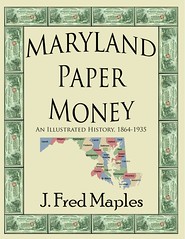 I first met Fred Maples, author of the recently published Maryland Paper Money, many years ago when
he worked for my wife. He and I got to talking and I found he was interested in numismatics but did not know where to start. As I do with
everyone in a similar situation, I asked them about where they live and used to live, and their ethnic background. Fred mentioned Bowling
Green, Kentucky and I immediately jumped on that city because I saw many exhibits of notes from there at the International Paper Money
Show in Memphis.
I first met Fred Maples, author of the recently published Maryland Paper Money, many years ago when
he worked for my wife. He and I got to talking and I found he was interested in numismatics but did not know where to start. As I do with
everyone in a similar situation, I asked them about where they live and used to live, and their ethnic background. Fred mentioned Bowling
Green, Kentucky and I immediately jumped on that city because I saw many exhibits of notes from there at the International Paper Money
Show in Memphis.
Fred jumped into Bowling Green notes and ended up writing some very excellent articles about them for the Bank Note Reporter. I think he sold those notes to get started into Maryland notes, and I knew he was about to do another excellent piece of writing about his new collection. I ordered his latest book and he has not disappointed me. It is an excellent book and I am betting it will be the "bible" for background information about Maryland national notes for a long time! I believe other collectors should buy this book and do the same thing for their states and territories before the information is lost.
There are many people mentioned in the book who I have met locally in the Northern Virginia, Washington, DC and Baltimore metropolitan area shows and conventions. His research and interviews were very extensive. I am very proud of Fred's accomplishments in numismatics, and he has definitely made his mark in our field!
To read the earlier E-Sylum article, see:
NEW BOOK: MARYLAND PAPER MONEY (www.coinbooks.org/esylum_v18n20a02.html)
Beware of Mega Red!
Dennis Tucker of Whitman Publishing writes:
I got a chuckle out of Brad Karoleff’s “Bears Beware” commentary, about the Guide Book of United States Coins, Deluxe Edition.
Steve Roach and I were chatting recently and I passed along these unconfirmed tales:
There are rumors that a cowboy in Texas lost his horse, panicked, and then finally found the animal asleep behind a copy of MEGA RED. Meanwhile in faraway Bangladesh, a rice farmer protected his homestead from a marauding Bengal tiger by lodging a copy of MEGA RED in the beast’s jaws. We’ve been unable to confirm reports that a pallet of MEGA REDs was responsible for overloading and sinking the Central America in 1857. And of course, famously, there are only three manmade constructions visible from outer space: the Great Wall of China, William Howard Taft’s trousers, and MEGA RED.
To read the earlier E-Sylum article, see:
NOTES FROM E-SYLUM READERS: MAY 17, 2015 : Bears Beware of Mega Red!
(www.coinbooks.org/esylum_v18n20a11.html)
The Rare Oregon Iron & Steel Company Notes
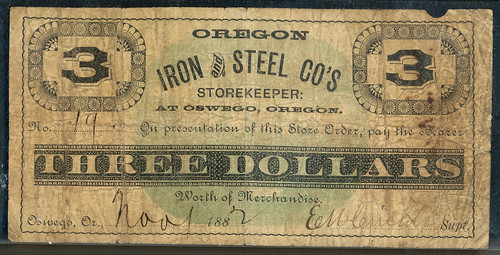
Regarding the rare Oregon Iron & Steel Company notes mentioned by Dave Schenkman last week, John and Nancy Wilson write:
We were at the sale of the Newman collection when the $2 from Oregon sold to Dave. We were at the Schingoethe sale in NY and purchased the attached $3 from Oregon. It is in our $3 State set of obsolete notes. As already stated it is probably unique.
To read the earlier E-Sylum article, see:
WAYNE’S NUMISMATIC DIARY: MAY 17, 2015 : Mining Scrip Notes
(www.coinbooks.org/esylum_v18n20a24.html)
Missouri, Kansas & Texas Railroad Medals
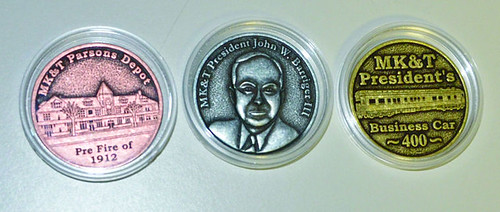
Jeff Starck of Coin World writes:
A new set of medals will be of interest to those from Parsons, Kan., and those who love railroad history. The MK&T (Missouri, Kansas & Texas) runs through town, and is the subject of three medals issued for the 2015 KATY days.
To read the complete article, see:
Coins commemorate railroad
(www.parsonssun.com/news/article_b9a04526-ff3b-11e4-b719-e76ec88e038c.html)

CONGRESSIONAL GOLD MEDAL AWARDED TO FIGHTER ACES
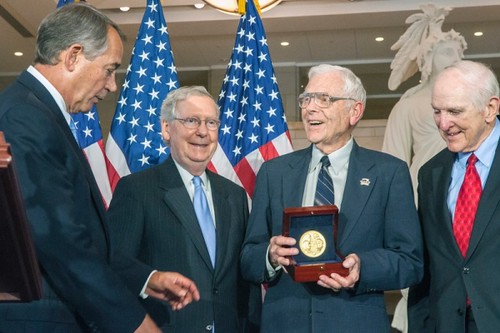
Air Force Lt. Gen. Charles "Chick" Cleveland flew 145 combat missions in Korea and Vietnam, shooting down at least five planes during a career in which he logged more than 4,500 flying hours.
The 87-year-old Cleveland is one of only 1,447 U.S. pilots designated as American Fighter Aces, a title reserved for those who shot down at least five enemy aircraft in aerial combat during World Wars I and II, Korea and Vietnam.
As president of the American Fighter Aces Association, Cleveland accepted another honor Wednesday on behalf of himself and the 76 other living members: the Congressional Gold Medal, Congress' highest civilian award.
"If there's an elite among fighter pilots, it's these men," Cleveland told a crowd of about 500 people at a Capitol ceremony that included about three dozen members of the elite fighter group.
The Fighter Aces "helped shorten the wars and saved lives," said Cleveland, of Montgomery, Ala. "These men are disappearing but must not be forgotten." House Speaker John Boehner said the daring missions flown by the Fighter Aces "changed the course of American-fought wars throughout modern history. These Fighter Aces risked it all to defend freedom and democracy around the world." Boehner, R-Ohio, was among several congressional leaders to speak at Wednesday's ceremony.
"We are the land of the free because of our fighter aces," said Rep. Sam Johnson, R-Texas, a former fighter pilot who flew 87 combat missions in Korea and Vietnam. "I cannot think of a more appropriate way to honor their heroism than with the Congressional Gold Medal."
Air Force Brig. Gen. Frank Gailer Jr., a World War II Fighter Ace, served as wingman for famed pilot Chuck Yeager. Gailer, 91, of San Antonio, called the ceremony "fabulous" and said he accepted the gold medal on behalf of himself and those who did not live to see it awarded.
To read the complete article, see:
American Fighter
Aces Receive Congressional Gold Medal Across 4 Wars
(www.military.com/daily-news/2015/05/22/american-fighter-aces-receive-congressional-gold-medal-4-wars.html)
The Congressional Gold Medal was presented to the American Fighter Aces collectively today during a ceremony in Emancipation Hall at the U.S. Capitol Visitor Center.
The medal was awarded to the American Fighter Aces in recognition of their heroic service to the United States throughout the history of aviation warfare. American Fighter Aces are military pilots credited with destroying five or more confirmed enemy aircraft in aerial combat during a war or conflict in which the U.S. Armed Forces have participated. Aces have served in World War I, World War II, the Korean War, and the Vietnam War. More than 60,000 fighter pilots have flown since World War I, but fewer than 1,500 are called Fighter Aces.
The medal’s obverse design features four pilots, representing World War I, World War II, the Korean War, and the Vietnam War; an ace of spades; and military wings with a centered globe, symbolizing the global impact of the group’s service. Inscriptions are “AMERICAN FIGHTER ACES,” “ARMY,” “NAVY,” “AIR FORCE,” and “MARINES.”
The reverse design features four aircraft used by American Fighter Aces and includes five stars to represent the minimum number of aerial combat victories required for certification. Inscriptions are “DUTY COURAGE AGGRESSIVENESS,” “2014,” and “ACT OF CONGRESS.”
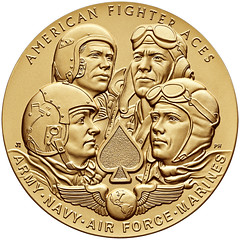
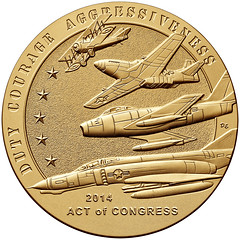
Obverse
Designer: Joel Iskowitz
Engraver: Phebe Hemphill
Reverse
Designer: Don Everhart
Engraver: Don Everhart
For more information, see:
American Fighter Aces Bronze Medal
(www.usmint.gov/pressroom/?action=Photo#FighterAces)
CHARLES LINDBERGH’S CONGRESSIONAL GOLD MEDAL
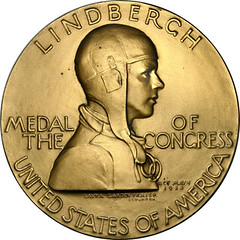
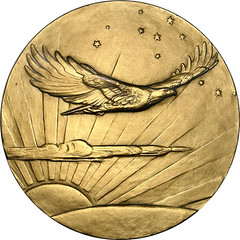
The reverse appears to have been inspired by one of Lindbergh’s nicknames, “The Lone Eagle.” The Congressional Gold Medal is but one of dozens of numismatic tributes to Charles Lindbergh’s achievement, and we will take a look at another one around this time next year.
To read the complete article, see:
CHARLES LINDBERGH’S CONGRESSIONAL GOLD MEDAL
(www.anspocketchange.org/lindberghs-congressional-gold-medal/)

THE D. BRENT POGUE COLLECTION: AN APPRECIATION
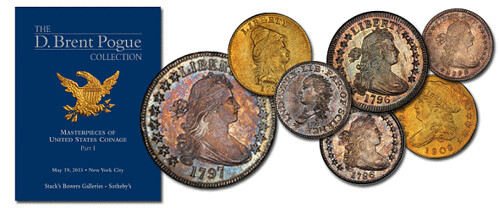
Interest in collecting American coins exploded in the few years preceding the Civil War, an era that saw the formation of the American Numismatic Society (ANS) in New York and the striking coins and medals expressly for sale to the growing legions of coin collectors. Numismatic auctions became commonplace up and down the eastern seaboard in the 1860s, and the most notable sale of that decade–that of the cabinet of Joseph J. Mickley of Philadelphia in 1867–netted an astounding $16,000 in sales.
In the century and a half since that explosion of interest in American coin collecting, there have been thousands of coin auctions. Billions of dollars worth of rare coins have crossed the auction block. American coins have been collected by kids gathering scarce dates from pocket change and by kings buying whole collections in a single stroke. The most famous collections have been built by marshaling significant resources over multiple generations. Through all of that, no one has ever built a collection like this before.
Not one of the great collections of the 19th, 20th, or 21st centuries had so many examples that were the finest known of their kind. Not one was built with such an unrelenting and uncompromising eye for quality. While all great collections are built from the constituent parts of past collections, none before the D. Brent Pogue Collection had ever taken greater advantage of the auction disposition of other legendary cabinets to assemble the finest-quality examples from each of those cabinets, picked like the choicest fruit from a expansive tree, and put them all together in one place.
This is a meta-collection, a collection that includes the best examples from every notable sale of the last quarter of the 20th century, an era that saw the dissolution of collections like Garrett, Norweb, and Eliasberg that had remained intact and off the market for a half-century or longer.
In so many of the major coin auctions of the last few decades, the numismatic cognoscenti would point to the best early American coin offered, the piece whose quality set it apart, and whisper that’s a Pogue coin. It was a compliment, a benediction even, to say that a coin was rare enough, fine enough, and important enough to be worthy of placement in the D. Brent Pogue Collection.
Without regard to the competition, many of those coins indeed became Pogue coins. If a coin of “Pogue Quality” wasn’t acquired for inclusion in the D. Brent Pogue Collection, it was because the collection already included a better one.
The first offering of the fruits of those extraordinary efforts are presented May 19th, 2015. They glitter and shine, each beautiful to behold. They tell stories about the founding of the nation and the establishment of its now dominant economy. They retain the names of all the great cabinets whose trays they have graced, names that define a fascinating narrative of the era since the coins stopped being tools of commerce and began being appreciated for their history, artistry, and quality.
To read the complete article, see:
The D. Brent Pogue Collection: An Appreciation
(www.coinweek.com/opinion/the-d-brent-pogue-collection-an-appreciation/)
For more CoinWeek coverage of the Pogue collection, see:
COINWEEK COVERAGE OF POGUE COLLECTION (www.coinweek.com/?s=pogue+collection)
A POGUE, PART I POSTMORTEM
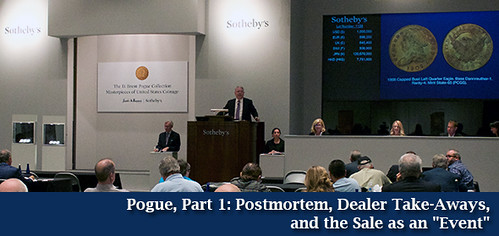
A light round of applause met the $2,000,000 hammer price that lot 1128–a rare 1808 quarter eagle–brought at Stack’s Bowers and Sotheby’s joint offering of the D. Brent Pogue Family Collection.
The coin, once part of Congressman Jimmy Hayes well-regarded type set, closed the door on the first of seven scheduled Pogue sales. It was one of three million-dollar-plus coins offered in an evening of remarkable early federal issues. Pogue’s 1796 Draped Bust quarter dollar (lot 1051 – a rare, high-grade first-year piece), brought $1,300,000 before the 17.5% buyer’s premium, and lot 1103–a 1797 Draped Bust half dollar, graded MS66 by PCGS–pulled in the same amount.
A stout price–and a shocking one, according to Kagin’s numismatist David McCarthy.
Before the clock struck 10:00 p.m., the evening’s festivities were over. Stack’s and Sotheby’s will return to the 1334 York Avenue auction floor tonight to offer a varied assortment of numismatic rarities, many remarkable in their own right. But the pent-up energy generated by the surprise announcement last year that Mack and Brent Pogue were bowing out has eased somewhat, though the collection’s headliners are yet to come.
The gallery was full of the usual suspects, including members of the New York numismatic scene and nationally-known dealers such as Laura Sperber and George Huang from Legend Numismatics, Doug Winter, Scott Travers, David McCarthy and Don Kagin from Kagin’s, Kevin Lipton and Harry Laibstain (to name but a few). Heritage Auctions sent representatives. And the Stack’s Bowers team was present in full force. Well, almost.
Of the company’s three scions, only two were present. Lawrence Stack worked the phones, while Q. David Bowers worked the crowd. Harvey Stack, unfortunately, had to watch the proceedings online, unable to attend due to a recent injury.
“My doctor said that I’m as good as new,” Harvey related to me via email. “But I watched the entire sale over the internet.” And that he did, summing up his opinion of the sale in another email to me just before midnight.
That Harvey Stack was able to watch the sale unfold through a live video feed from the comfort of his home speaks to the fundamental shift in the rare coin auction scene that’s taken place since the last time Stack’s Bowers and Sotheby’s teamed up in 2001 to sell the 1933 double eagle.
Auctions cast a much wider net of potential participants now as individual collectors can bid on items without the expense of travel or hiring a buying agent. While the floor was filled with interested spectators (the sale was a “happening”), there were far fewer paddle raisers in attendance. Much of the action was coming in over the phone or from online bidding.
Of course, there were exceptions.
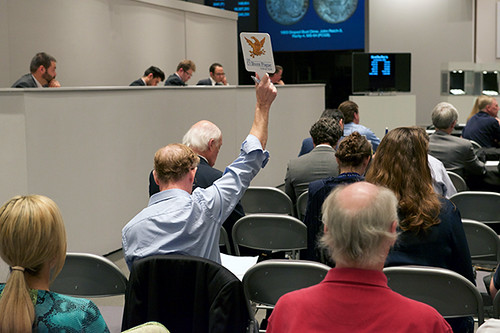
David Quint bidding on the Pogue 1803 dime.
Collector David Quint rampaged through the Pogue dimes, his paddle raising with such frequency in the sale’s early going that his fellow collectors took note and a staff photographer from the New York Times took perch, training her lens on him in anticipation.
The 128-lot offering brought more than $25 million with buyer’s premium, which amounts to $195,312.50 per lot–a coin-by-coin record price. What’s amazing about this number is that 16 of the 128 coins sold for less than $20,000 (Trivia time: the lowest price realized of the night–about $4,994 with buyer’s premium–went to lot 1026, an 1834 Capped Bust half dime in PCGS MS66).
Brent Pogue and his family–including his father and co-collector Mack Pogue–were on hand for the sale. The family kept a low profile and watched the sale unfold from a private box overlooking the sales floor. Brent made a few brief appearances; once before the start of the sale, a second time during the bidding for lot 1103 and one last time at the end of the sale, when he was surrounded by well-wishers and Stack’s Bowers and Sotheby’s personnel.
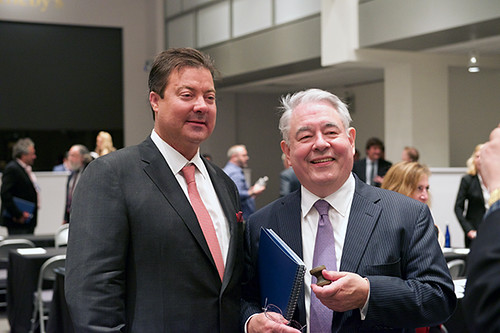
D. Brent Pogue with Sotheby’s Auctioneer David Redden
To read the complete article, see:
Pogue, Part 1: Postmortem, Dealer
Take-Aways, and the Sale as an “Event” (www.coinweek.com/coins/news/pogue-part-1-postmortem-dealer-take-aways-sale-event/)
HARVEY STACK AND D. BRENT POGUE
Some 40 or so years ago a nice young man , D. Brent Pogue,(Brent ) and his father Mack Pogue visited Stack's on West 57th Street to look at coins. Brent was amazed to see so many coins, all displayed in sit down showcases, with many numismatic documents on the wall along with historical statuary about. Brent went from showcase to showcase, telling his father who accompanied him that this surely was a vast display of rare coins, in all grades.......................
After his trip about the showcases he took a chair next to his father, and took out a list of items that he would like to see to add to his collection. He was pleased that we had a goodly number of these in stock, from current issues that were made for daily commerce, to rarities that survived the test of time and were available from our stock. We had coins that came from current rolls, and rarities such as the original set of St. Gaudens Coins which included two varieties of the Ultra High Relief Double Eagles.
Having read and studied numismatics at home with whatever publications he could find, Brent had developed a full understanding about what grade and strike had to do with desirability of coins, and reviewed all we showed him and decided what he wanted to add to his collection.
Within a few months he returned to NY and visited us once again, this time with our auction catalog for that month in his hands. Whenever, we , the Stack Family met a collector who showed such interest, we put them on our mailing list to get all Auction Catalogs and Price Lists we published
Brent looked at some of the lots in the sale, asked about who catalogued the major coins in the sale, and I told him that our lead cataloguer at that time was Norman Stack, my first cousin. He asked to meet him and I took Brent to one of our back offices, in which Norman worked, who was at a Partner's Desk ,so we could face each other when working, and the room was surrounded by books on Numismatics which were part of our Reference Library. (A prize winning assemblage as proclaimed by all who visited and were allowed to use the books)
Brent and Norman entered into a deep discussion on Numismatics, and Norman tried to explain to Brent how he developed interests in all coins and had a particular interest in assembling a Type Collection of U.S. Coins. As Brent had a great fondness for the classic American issues from 1792 to 1838 in all denominations, they had a common ground to discuss. Norman showed Brent the Type Set he was developing, so he could also write a book on this method of collecting, and Brent became fascinated with what he saw and learned from Norman. I sat with both of them and enjoyed the questions and answers as well.
"Your set is wonderful, great coins, great strikes, great color, great eye appeal, and I want to do the same, maybe better . It will not be easy but I will enjoy the challenge !" Norman replied, "It will be my pleasure to help you." So we all became friends, and we developed a potential new collector to serve.
Now that plans and goals were decided on, Brent, with the help of his father Mac began searching and acquiring coins of importance and rarity from the many collections that were marketed for the past 40 years. No one collection could offer more than one or two, at best, and though some were seen which was considered outstanding, they did not meet the standards set forth by Brent. During the past 40 years, Brent was fortunate that collections built in the 1930's to 1950's were dispersed and became part of collections sold during the period he collected.
His demands were very strict, he wanted the Finest he could find, they had to be well struck, have super surfaces, no major impairments what so ever, a natural toning that survived the the tests of time with beauty and "great eye appeal" and then he would consider buying it.
Stack's surely got a major share of premium collections to sell during this building , but Brent went all over the country to look at, examine offerings as they became available at auctions of other auction companies Stack's, from collections they owned and bought also offered many additions to his collection, but the standards he set, tutored by Norman, were difficult to meet with every addition he made to his vast collection.
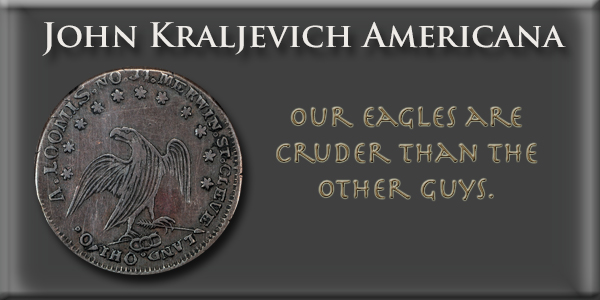
THE BOSTON CORN EXCHANGE HOTEL TOKEN
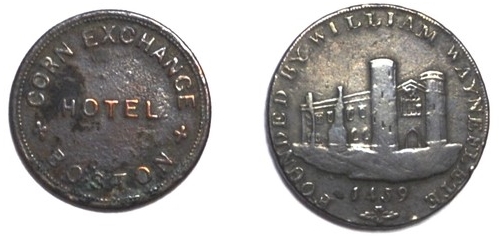
A 1459 token especially minted for the Corn Exchange Hotel in Boston has been unearthed by a former Boston councillor.
The 1459 token – pictured at the top – was especially minted for the Corn Exchange Hotel in Boston and worth three old pennies – just over 1p in today's money.
The Corn Exchange was located where Marks and Spencer is situated today in the Market Place.
The other coin is dated 1793 and is a Wainfleet halfpenny, top, right
On one face it features Wainfleet Hall, which housed Magdalen College School, founded in 1484 by William of Waynflete.
Mr Richmond added: "The Wainfleet halfpenny features on one face an image of the hall and on the reverse a woman with a ship's anchor and a ship in the background.
The tokens are not believed to be of significant value according to Boston's Magpies Nest which specialises in collectibles, antiques and vintage items.
Owner Des Ellerby said: "Such tokens, which were privately minted, came into existence as there was a shortfall of small denomination coins for everyday transactions.
"The edge of such coins should be inscribed 'Payable at the Warehouses of D.Wright & S.Palmer'. Although the Wainfleet Halfpenny can currently be seen on the internet at prices up to £150 each but in reality actual sales over the last 12 months have seen a price range of 99p to £28.76 per token with condition being paramount. The selling prices indicates this coin is common.
"The Corn Exchange Hotel Boston 3d Token is also 19th Century although the coin itself does not appear dated."
To read the complete article, see:
Coin booty reveals
history of Boston's own currency
(www.bostontarget.co.uk/Coin-booty-reveals-history-town-s-currency/story-26529227-detail/story.html)
QUERY: WHAT’S AN OBVERSE?
Regarding the Archer M. Huntington medal pictured last week, Dick Johnson writes:
Wow! A medal with two obverses. We still have the two reverses at Medallic Art Company. Owners of these two must pick up a reverse in person. Strange, however, the two reverses match the obverses!
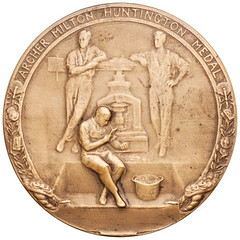
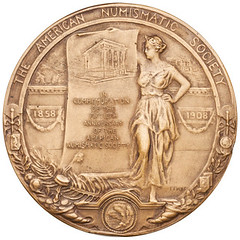
In everyday speech the "heads" side is what we numismatists call the obverse - typically the side with the head or figure of a statesman, historical figure, or symbolic representation of Liberty or the issuing nation. The Huntington medal has human figures on both sides. Does each meet the definition of "obverse"? -Editor
To read the earlier E-Sylum article, see:
THE ARCHER M. HUNTINGTON MEDAL (www.coinbooks.org/esylum_v18n20a12.html)
QUERY: WRITER OF GROGAN COLLECTION LETTERS SOUGHT
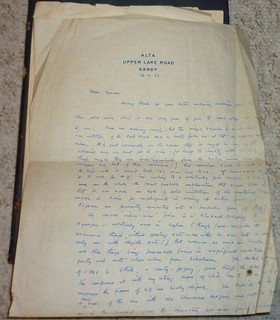 I
would like to appeal to E-Sylum readers to help me identify the writer of two letters dated to 1922 I found amongst other manuscript items,
mainly relating to Ceylon coins and tokens, in a bound copy of the J Schulman of Amsterdam catalogue of the H T Grogan collection. Grogan
collected coins issued by the colonies of European countries, and the sale was held on 23 February 1914. The catalogue is a bit outside my
collecting interests, but I couldn't resist it because of the material that came with it.
I
would like to appeal to E-Sylum readers to help me identify the writer of two letters dated to 1922 I found amongst other manuscript items,
mainly relating to Ceylon coins and tokens, in a bound copy of the J Schulman of Amsterdam catalogue of the H T Grogan collection. Grogan
collected coins issued by the colonies of European countries, and the sale was held on 23 February 1914. The catalogue is a bit outside my
collecting interests, but I couldn't resist it because of the material that came with it.
The letters were all addressed to "Dear Symons", and there are the initals "CTS" in gilt on the leather spine. Using Manville & Robertson's book on British Numismatic Auction Catalogues I quickly found the 24 February 1943 Sotheby sale that included coins from the late Claude Trevine Symons of Ceylon.
I really now want to identify the letter writer, but this is proving difficult as his writing is tricky to read. Both letters are from Alta, Upper Lake Road, Kandy, which is in Ceylon (now Sri Lanka). In one letter he says he is "dancing mildly over handing you a new var of the Galle 2s on a platter" ie a Ceylon 2 stuivers, as he had not checked further than the date and it was the first 1783 he had seen without a colon below. In the other letter Symons had sent him rubbings of gold coins, one of which the letter writer identified as an imitation of the Porto Novo pagoda.
I have attached images parts of the letters and his signature, and would be grateful for any suggestions for a name.
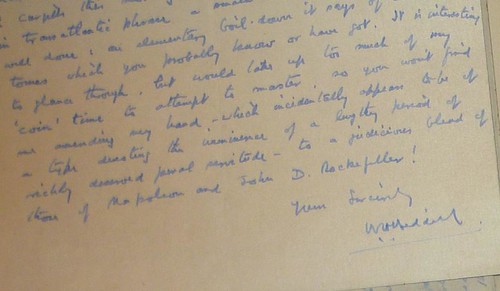
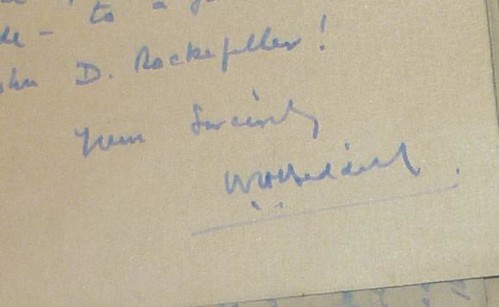

Archives International Auctions, Hong Kong 5
The Alexander I. Pogrebetsky Family Archives of Chinese & Asian Banknotes
Highlights include:
- Lot 2474 Mercantile Bank of India, 1937 Issue
- Lot 2119 Yue Soo Imperil Bank, 1908 Silver Dollar Issue
- Lot 2024 Bank of Territorial Development, 1915 Issue 5 Dollars
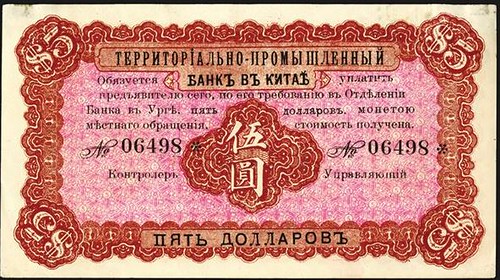
1580 Lemoine Avenue, Suite #7
Fort Lee, NJ 07024
Phone: 201-944-4800
Email: info@archivesinternational.com
WWW.ARCHIVESINTERNATIONAL.COM
MEDAL EXHIBIT: RETRATS DE MEDALLA
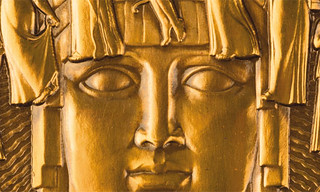 E-Sylum readers might be interested in the medal exhibition called ‘Retrats de medalla: l'espectacle del bronze’ (Medal
portraits: The Spectacle of Bronze) housed by the Fundacío Rafael Masó (Girona/Spain), which is open from March 21 until Sep 12, 2015.
Curator and main lender for the display is Rossend Casanova, art historian numismatist and collector. Some information in Catalan language
can be found here: www.rafaelmaso.org/cat/medalles.php
E-Sylum readers might be interested in the medal exhibition called ‘Retrats de medalla: l'espectacle del bronze’ (Medal
portraits: The Spectacle of Bronze) housed by the Fundacío Rafael Masó (Girona/Spain), which is open from March 21 until Sep 12, 2015.
Curator and main lender for the display is Rossend Casanova, art historian numismatist and collector. Some information in Catalan language
can be found here: www.rafaelmaso.org/cat/medalles.php
The exhibition is accompanied by a bilingual (English/Catalan) small-sized catalogue with 194 pages. The texts cover topics such as war medals, religious portrait medals, allegories and animal portraits, the renewal of the medal in the 19th century and the rise of the Catalan medal. The price of the catalogue is €14. A small extract of the catalogue can be viewed here: http://issuu.com/ajuntament_girona/docs/retrats_de_medalla
The foundation Rafael Masó is open 7 days per week, its address is Ballesteries, 29, 17004 Girona, Spain. Staff can be contacted by email info@rafaelmaso.org or via telephone (972 413 989).
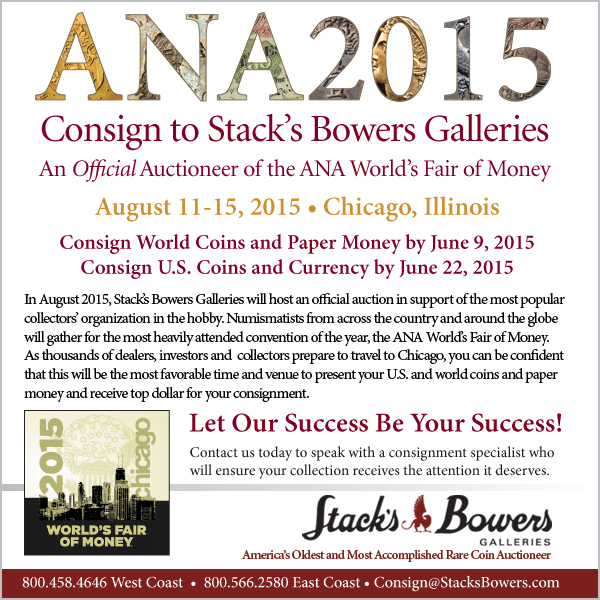
BANKNOTE ENGRAVER LORENZO HATCH
As a gift for my 70th birthday, my son Rocky offered to be my interpreter on a trip to Dorset, Vermont, the hometown of Lorenzo Hatch (1856-1914). Many American numismatists will recognize the prominent, turn-of-the- century bank-note engraver and painter as the creator of the Ulysses S. Grant portrait featured on the face of Series 1886-91 $5 Silver Certificates and on the back of Series 1896 $5 Silver Certificates. Later in his career, Hatch was invited to China to help its government establish the Chinese Bureau of Engraving and Printing.
I was taught engraving by an artist who had studied under the legendary Hatch, and it has been a long-cherished dream of mine to visit the artist’s birthplace. During our trip to America, we also toured the East Coast and explored a great variety of museums, galleries, mints and bank-note printing facilities.
We arrived in Dorset on the evening of August 7, 2013. Jon Mathewson, curator of the Bley House Museum, and board members of the Dorset Historical Society were waiting for us. We shook hands and hugged, and Mathewson showed us around Hatch’s former home (now the office of Josiah Allen Real Estate) and his studio, which still stands in the backyard. The studio contained a skylight that was perfect for drawing, and Hatch’s easel was set up in the room as if he had never left.
Mathewson suggested we visit the cemetery, so we walked to the graveyard at sunset as rays of golden light streamed through the trees and illuminated Hatch’s tombstone, which read: LORENZO J. HATCH JULY. 16.1856. FEB.1.1914. I bowed three times to pay my respects to the renowned artist who helped introduce the steel-engraving tradition in China.
The next morning, we headed to the Bley House Museum. Mathewson had invited the retired curator, Richard Hittle, and his wife to join us. Maps of Dorset, unearthed relics and pictures of the Vermont town are displayed on the museum’s ground floor. The upstairs is home to Hatch’s works: bank notes, portraits, landscapes, oils, watercolors, sketches and other artwork. Next, we visited the Southern Vermont Arts Center, where many of Hatch’s portraits of his wife and mother are on exhibit. Hatch rendered many paintings of his mother that demonstrated his deep love for her. One of these pieces especially appealed to us—the warm hue and affable expression on his mother’s face were reminiscent of Rembrandt’s style.
We admired Hatch’s work while listening to the curator’s live presentation about the artist and engraver, and were impressed by the museum’s holdings of many rare documents. Its collection includes small-size engravings, yellowed family correspondence, newspaper reports, and sketches, each of which conveyed bits of the engraver’s remarkable life story. We talked and shared stories about Hatch, many of which were not widely known, especially his tremendous contribution to China’s bank-note printing industry during his six years there.
In the early 1900s, the Qing government decided to emulate advanced printing methods used in western countries and issued national currency notes controlled by the central government.
The United States Bureau of Engraving and Printing (BEP) was famous for its intaglio bank notes produced from hand-engraved steel plates. Dr. Chen Jintao, the Yale-educated vice president of China’s Board of Finance, recommended building a printing facility based on the American model, using BEP methods to thwart counterfeiters.
Lorenzo Hatch was a well-known American engraver whose skill was respected by Chinese officials.
In 1908 the representatives visited Hatch on behalf of the Qing Dynasty and with the approval of the United States Department of the Treasury. They discussed setting up the operation, which would allow China to produce its own stamps and currency. After some initial reluctance, Hatch signed a six-year contract with the Chinese government.
For more information on the American Numismatic Association, see:
www.money.org
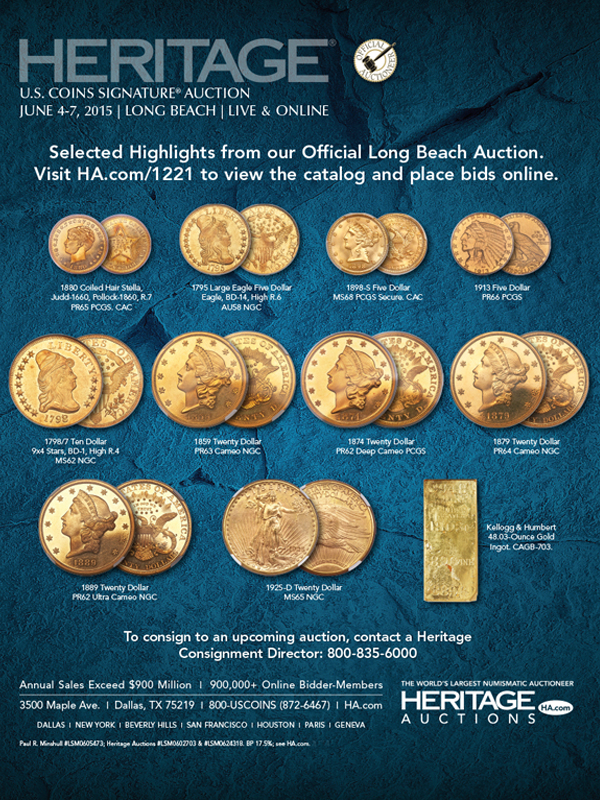
INTERVIEW: KATHERINE VAN SCHAIK
And how did you get interested in numismatics?
I did my undergraduate degree at Harvard College, so I had interacted with Carmen Arnold-Biucchi at that time. She taught a section on coins for a course I was taking, and the idea she communicated to our section — that you could see and hold something that someone had seen and held and used so long ago — was just incredible to me. And that’s what I really like about coins: the opportunity to do ‘hands-on’ history.
What brought you to the ANS today?
The breadth and depth of the collection.. Harvard has a fantastic collection and what’s available on the ANS website is great, but being here and actually seeing these trays of coins was transformative. You can see all of the different varieties and changes next to each other. I can look at a coin from a healing sanctuary in Cos and then I can compare it to a coin from Epidaurus. It’s the intensity and immediacy of the comparison that makes for a really fruitful research opportunity.
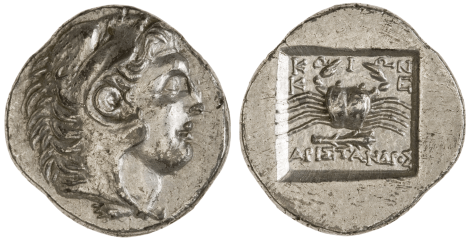
Could you talk about a coin that you saw today that you found particularly important?
One that I found interesting is this silver drachm from the island of Cos, which had a huge temple to Asclepius and also is supposedly where Hippocrates was born and taught medicine. The word cancer that we use to denote neoplastic growth was used in Greco-Roman antiquity to mean any kind of hardened lump on the body. We’re not sure exactly if it was cancer in the sense that we would understand cancer or if it was an abscess or some other form of swelling. It’s clear that the word (καρκίνος) could mean ‘cancer’ in the sense that we now understand but the term did not apply to this pathological condition exclusively. In a medical context, the word καρκίνος is descriptive, in that its literal meaning is ‘crab’. The image of the crab is very common for coins from the island of Cos, and it is hard to prove this idea, but I do wonder if there is some connection between the iconography of the crab and the idea that one goes to Cos to be healed of the swelling called a καρκίνος. I don’t know if there’s a pun or some kind of link with what happened at the healing sanctuary and the iconography. And it might be something impossible to prove, but its something I am considering in my research at the moment.
To read the complete article, see:
PROFILES IN RESEARCH: KATHERINE VAN SCHAIK
(www.anspocketchange.org/profiles-in-research-katherine-van-schaik/)
THE MUSES ON ANCIENT COINS
Calliope
The nine Muses were the daughters of Zeus and Mnemosyne, the personification of memory. The Muses represent the inspiration of literature, music and the fine arts. According to one tradition they lived on Mount Helikon (elevation 1,749 meters, or 5,738 ft.) in Boeotia. Another story places their home beside the Pierian spring, at the foot of Mount Olympos (2,919 meters, or 9,570 ft.).
Chief among them was Calliope.
Calliope (or Kalliope) means “beautiful voice.” She presided over Epic Poetry and Eloquence. Her distinctive symbol was a writing tablet, but on this coin she plays a lyre (a seven-stringed instrument often used to accompany the recitation of poetry). The symbol behind the bust of Apollo on the obverse is a key, for unknown reasons.
Melpomene
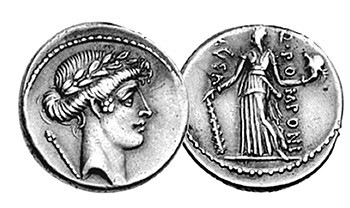
Melpomene means “to sing in a choir” or “be melodious.” As the Muse of Tragic Drama, her symbol is a tragic mask. On the reverse of the coin, she holds the mask in one hand and the club of Hercules in the other. She wears a short sword at her belt, symbolizing the (off-stage) violent bloodshed so common in Greek tragedy. The symbol behind Apollo’s neck on the obverse is a scepter, since classic tragedy often dealt with the doings of kings.
Terpsichore
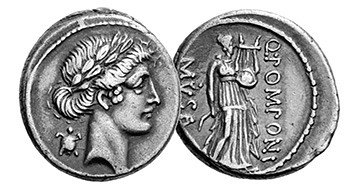
Terpsichore means “delight in dancing” As the Muse of Dance, her symbol is the lyre. On the reverse of the coin, she holds the lyre in her left hand and the plectrum (a large pick used to pluck or strum the strings) in her right. On the obverse, the symbol behind Apollo’s neck is a tortoise, because the sound-box of the earliest Greek lyres was made from the shell of a tortoise.
This is a relatively common issue, with 92 examples in the Coinarchives database. Prices in recent sales have ranged from $280 to over $3,600 for an exceptional specimen[2]. Some of these may be erroneous attributions, however; coins with a flower on the obverse and a large, flat-bottomed kithara–rather than a small round-bottomed lyre–may have been intended to honor Erato, the Muse of Lyric (or Erotic) Poetry.
Urania
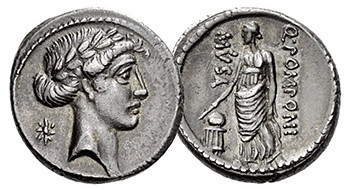
Urania means “heavenly.” As the Muse of Astronomy her symbol is the celestial globe. On the coin she holds a pointer indicating the globe on a low stand. On one particularly well-preserved example, lines of latitude and longitude can be seen inscribed on the globe[7]. On the obverse, the symbol behind Apollo is an eight-pointed star.
To read the complete article, see:
Nine Ladies Dancing: The Muses on Ancient
Coins (www.coinweek.com/ancient-coins/nine-ladies-dancing-muses-ancient-coins/)
THE BOOK BAZARRE
ANA 2015 SUMMER SEMINAR SCHEDULE ANNOUNCED
Numismatic Paper of Early America
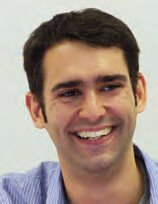
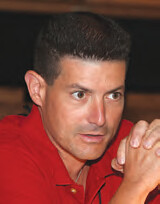
John Kraljevich and Eric Goldstein
Among America's pioneering achievements is its early and widespread use of paper as currency. Beginning in Massachusetts in 1690, early America funded multiple wars and a variety of other projects with bills of credit. Shortages of coin and the demands of a diverse and rapidly growing economy led to creation of hundreds of sorts of monetary paper: bonds, checks, bills of exchange, stock shares, promissory notes, and more. Learn about what kind of paper received the hated stamps of the Stamp Act and just how worthless a Continental was from two of the leading experts in the field. This in-depth treatment of colonial currency, fiscal paper, and more will incorporate historical context, printing technology, collecting strategies, market observations, preservation issues, and the opportunity to examine hundreds of items hands-on in a fun, conversational environment. Instructors: John J. Kraljevich Jr., columnist for The Numismatist and professional numismatist, John Kraljevich Americana (www.jkamericana. com); and Erik Goldstein, curator of Mechanical Arts and Numismatics, Colonial Williamsburg Foundation (www.history.org)
An Introduction to the Numismatics of Mining
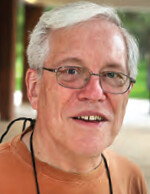
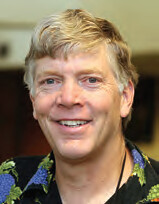
David Schenkman and Fred Holabird
Jetons and Counting-Tokens: Computation and the Commercial Revolution
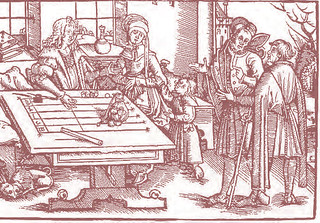
As trade expanded in Europe during and after the Crusades, jetons and counting-tokens came into widespread use as a means of mathematical computation. This interesting series of “coins” speaks directly to the emergence of new markets, trade routes, and the merchant class that needed the means and methods of business accounting. This course will survey the types and identification of jetons and counting-tokens in the social and economic context of late Medieval Europe. Actual tokens and counting methods will be reviewed from this interesting era. This is a general survey course for anyone interested in the origins and context of money, trade, banking, and the merchant class of late Medieval through Renaissance Europe. No prior knowledge is required, and time will be allowed for class discussion in the seminar setting. Instructor: Greg Thompson, medieval coin enthusiast and owner/operator, Money-Changers
For more information, or to register, see:
www.money.org/summer-seminar
THE BOOK BAZARRE
HEINRICH WIELAND'S NOBEL MEDAL SELLS FOR $395,000
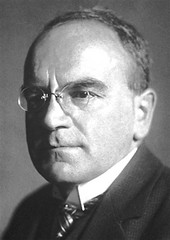 The Nobel Prize gold medallion that German biochemist Heinrich Otto Wieland won in 1927 has been sold at auction for $395,000. And although
that figure may not compare in monetary terms to the multimillion-dollar sales of James Watson's and Francis Crick's medals, the
story of the prize and the man who won it is priceless.
The Nobel Prize gold medallion that German biochemist Heinrich Otto Wieland won in 1927 has been sold at auction for $395,000. And although
that figure may not compare in monetary terms to the multimillion-dollar sales of James Watson's and Francis Crick's medals, the
story of the prize and the man who won it is priceless.
The medal, accompanied by a letter of authenticity from the chemist's grandson, Heinrich Wieland, was sold to an anonymous bidder on Thursday through Los Angeles-based Nate D. Sanders Auctions. The $395,000 includes the buyer's premium, Sam Heller, a spokesman for the auction house, told NBC News.
The elder Wieland won the Nobel for his study of bile acids and related substances, such as cholesterol — but he's equally well-known for his personal courage after winning the prize. When Nazi-era laws called for the expulsion of Jewish students and others who were considered "racially burdened," Wieland kept the students in his group safe by designating them as his personal guests. He even tried to protect a student who was linked to an anti-Nazi resistance movement. (Unfortunately, Wieland failed.)
To read the complete article, see:
Nazi-Defying
Chemist Heinrich Wieland's Nobel Prize Sells for $395,000
(www.nbcnews.com/science/science-news/nazi-defying-chemist-heinrich-wielands-nobel-prize-sells-395-000-n352291)
In a rare display of civic courage, Wieland testified on behalf of Leipelt, who was nevertheless condemned by a Nazi court and executed in early 1945.
Since 1901, a total of 889 Nobel Prize medals have been awarded, of which only eight were sold or auctioned off by the recipients or their descendants. The prize for Wieland’s 23-karat medallion is in the middle range of the eight sold.
To read the complete article, see:
Nobel medal
of German doc who shielded Jews fetches $395,000
(www.jta.org/2015/05/01/news-opinion/united-states/nobel-medal-of-german-doc-who-shielded-jews-fetches-395000)
SOTHEBY'S PLANNING MONEY-THEMED ART SALE
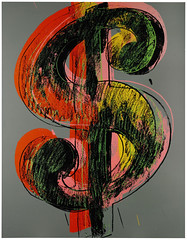 It's not exactly newsworthy that an auction at Sotheby's will be all about the Benjamins, but this time it's a bit more
literal. The upcoming sale of a money-themed collection at the London auction house, according to the Los Angeles Times, boasts 21 works by
contemporary artists that feature the almighty dollar bill. The sale, titled, "To The Bearer On Demand," will take place on July
1st as part of Sotheby's contemporary evening auction, and is expected to fetch between $62.8 million and $92.6 million.
It's not exactly newsworthy that an auction at Sotheby's will be all about the Benjamins, but this time it's a bit more
literal. The upcoming sale of a money-themed collection at the London auction house, according to the Los Angeles Times, boasts 21 works by
contemporary artists that feature the almighty dollar bill. The sale, titled, "To The Bearer On Demand," will take place on July
1st as part of Sotheby's contemporary evening auction, and is expected to fetch between $62.8 million and $92.6 million.
The pieces hail from a single private collector in Europe, and the collection features works by Andy Warhol, Keith Haring, Joseph Beuys, Wang Jin, Zheng Liu, and the art duo Tim Noble and Sue Webster.
The highlight of the sale is Warhol's One Dollar Bill (Silver Certificate)(1962), which is expected to sell for up to $30 million. Also featured will be Front and Back Dollar Bills, a silkscreen that features multiple bills, as well as the 1981 works Dollar Sign and Dollar Signs.
The 21 works will be on display at Sotheby's in Los Angeles today, before heading to London. The July 1st contemporary auction will also feature pieces by Francis Bacon, Gerhard Richter, and Jean-Michel Basquiat.
To read the complete article, see:
Naked Avarice Grips Art World as Sotheby's Offers $93 Million
Money-Themed Sale ()https://news.artnet.com/in-brief/sothebys-money-auction-300717
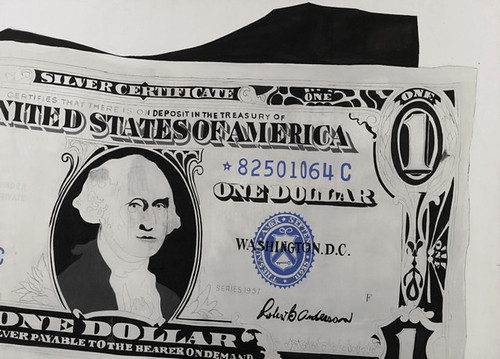
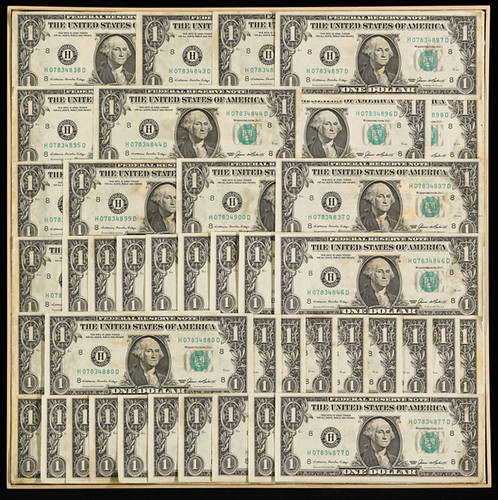
Take a Look at the Blinged-Out Paintings in the Money-Themed Auction at Sotheby’s (www.vulture.com/2015/05/blinged-out-paintings-in-sothebys-money-auction/slideshow/1/)
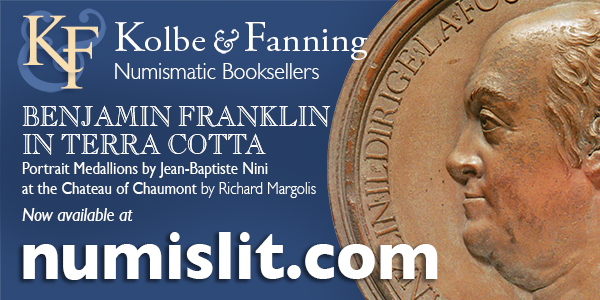
A 1949 CADILLAC COVERED WITH CENTS
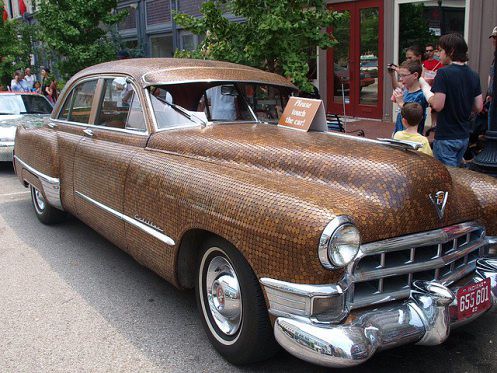
What a great job he's done. Looks quite professional. I want to know how long it took to glue on 200 lbs of pennies. He's got to be retired. So, if the bank and government DO NOT want your pennies, do check this out... Who said it can't be done??? I think what happened here is the man told his wife he needed to paint his car and when he told her how much it would cost,
She told him to “save his pennies.” The $383.00 Paint Job. The 1949 Cadillac, is completely covered with 38,295 pennies! They were affixed one by one using Silicone. They added over 200 pounds to the vehicle's weight. The entire project took 6 weeks. The pennies are American, and include an 1817 "Big Cent", two Error Pennies, and four 1943 Steel pennies; (but who's counting?). And, it won't scratch.
To read the complete article, see:
The $383 Paint Job
(https://yougottobekidding.wordpress.com/2014/04/09/the-383-paint-job/)
